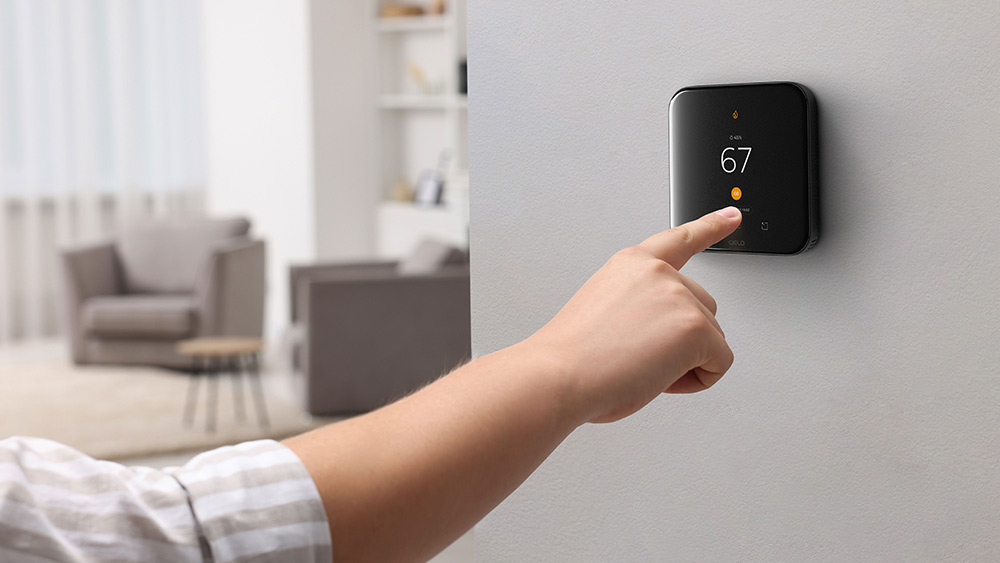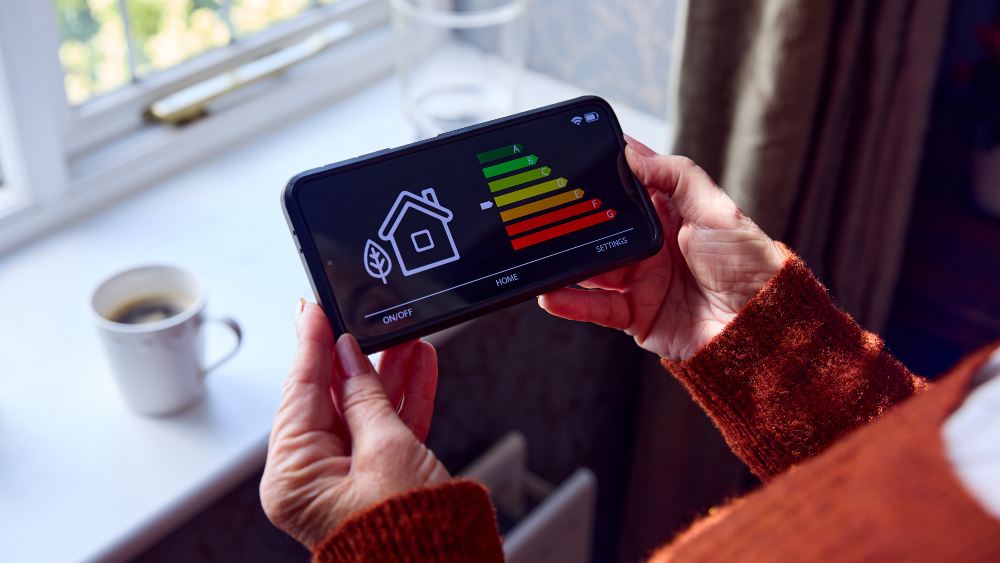
Key Takeaways
- HVAC systems consume a major chunk of residential electricity usage.
- Regular maintenance tasks like cleaning filters can improve energy efficiency.
- Upgrade to a smart thermostat to prevent unnecessary energy consumption and track energy usage.
From HVAC systems that maintain your ideal climate to refrigerators that keep your food fresh, electrical home appliances have become an essential part of modern living, but have you ever wondered what uses the most electricity in your home?
According to a survey by the Energy Information Association (EIA), heating and cooling systems are the biggest culprits of residential electricity consumption in the US, followed by water heaters, lighting, and refrigerators.
Given the rise in energy costs, it’s more important than ever to understand which appliances contribute significantly to your bills. By being mindful of your energy consumption and making informed choices, you can effectively manage your home energy usage and save money on electricity bills.
How Much Energy Does the Average House Consume?
According to EIA, the average annual amount of electricity sold to US residential customers was 10,791 kilowatthours (kWh) in 2022, which equates to about 899 kWh per month.
The actual amount of power a household consumes is dependent on a number of factors. The size of the home, the building materials used, and the number of residents all play a role in determining power consumption. Not only that but the number and type of appliances in a home, as well as how often they are used, also contribute to the amount of power needed. Additionally, the location of a home can impact power usage, as climates and weather conditions can affect the need for heating and cooling systems.
8 Highest Energy Users and Ways to Mitigate Their Impact
If you’re wondering what uses the most electricity in your home, then here are the top 8 energy users you need to know about.
1. HVAC Systems
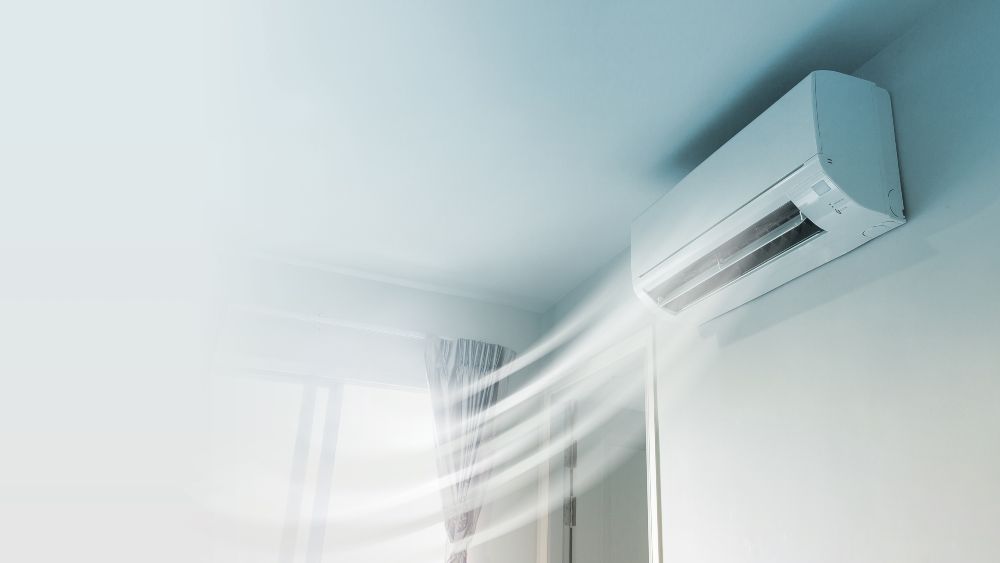
HVAC systems are a staple in many homes, providing a comfortable indoor environment regardless of the outside temperature. However, these systems consume enormous amounts of energy to maintain the desired temperature, which can contribute significantly to your monthly energy bills.
The air conditioning system alone consumes 19% of household electricity, while space heating accounts for 12%.
Here are some ways you can minimize the energy consumption of your HVAC system:
- Investing in a smart thermostat for central systems or a smart thermostat for room units is a great way to automate your home climate and keep your bills in check. Many smart thermostats can be controlled remotely via a mobile app. If you forget to adjust the thermostat before leaving, you can do so from your smartphone, preventing unnecessary energy consumption.
These smart devices allow you to create a schedule for your heating and cooling system based on your daily routines. This ensures that your HVAC system operates efficiently when needed and does not waste energy when you’re away or asleep. In addition, many smart thermostats provide detailed reports on your energy usage patterns. This information can help you identify trends, understand your consumption habits, and make informed decisions to optimize energy efficiency further.
Your best choice to make any mini-split, window,
or portable AC smart. Enhance your comfort and savings.

- Use ceiling fans to keep yourself cool in summer. You can also use them in conjunction with air conditioning and adjust your thermostat a little higher to save on bills. Check out this comparison between fans and ACs. You can also use fans in winter; you just have to adjust the direction clockwise. This will push the warm air downward, making your room feel warmer.
- Use passive cooling techniques to keep your home cool. These techniques help reduce the need to use mechanical systems such as air conditioning, thus cutting down energy bills and reducing carbon emissions. In winter, passive solar heating is a great way to reduce your heating bills by relying on the sun’s warmth to keep your home warm.
- Prevent drafty windows that may cause heat to escape your home or cool drafts from entering inside.
- Take time for regular HVAC maintenance for maximum efficiency and savings.
2. Water Heaters
Did you know that water heaters can account for almost 14% of your household’s electricity usage? That’s a significant chunk of your monthly expenses!
Water heaters are essential for providing hot water for various household tasks, including showers, washing machines, sinks, and dishwashers. These appliances typically run for about three to five hours every day, consuming a significant amount of electricity.
To help reduce the amount of power your water heater consumes, there are a few things you can do.
- One of the simplest ways is to switch to cold washes when doing laundry.
- Turn off the water heating option on your dishwasher.
- Insulate your hot water storage tank and the pipes connected to the tank to prevent heat loss.
- Take short showers so less energy is utilized in heating water.
3. Lighting
When it comes to energy consumption in the home, lighting takes third place on the list. It accounts for approximately 10.3% of residential electricity consumption, making it an important area to focus on when looking to reduce overall power usage.
It’s important to note that even small habits like turning off lights that aren’t being used can have a significant impact on your energy bill.
- LED bulbs use 75% less energy than incandescent bulbs and have a lifespan of up to 25 times longer.
- In the winter months, take advantage of natural light to help heat your home while also saving on energy costs.
- For festive holiday lights, opt for LED options and put them on timers to prevent them from staying on all night.
- For outdoor lights, install motion detectors to ensure they only turn on when you need them.
4. Refrigerator
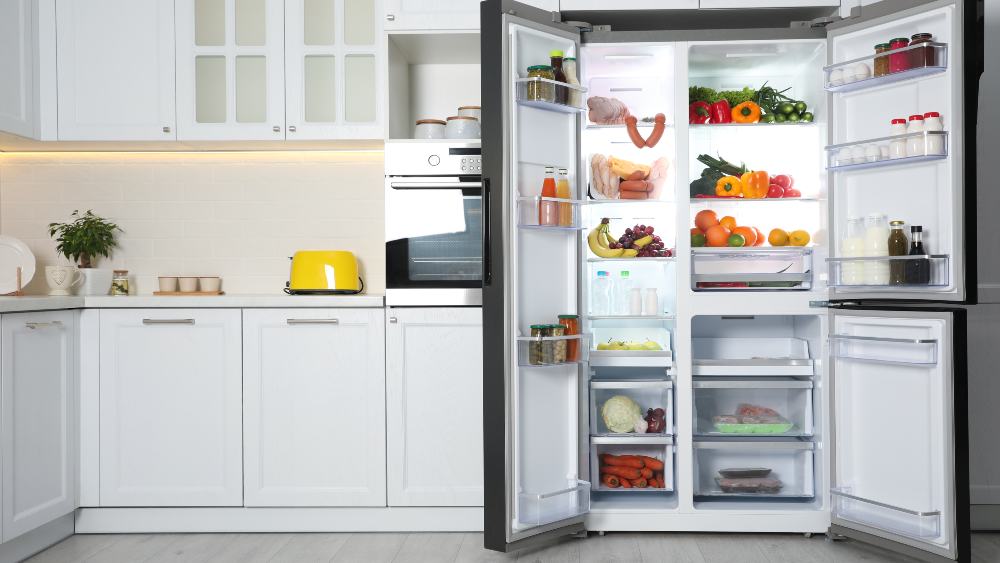
When learning about what uses the most electricity in your home, refrigerators play a crucial part. They are essential household electrical appliances, with an overwhelming 99.8% of US households having at least one. One in four American households has more than one fridge.
Due to how they operate, refrigerators have to run all the time and consume a big chunk of your household energy. 7% of your electricity consumption, while separate freezers account for 1.6%.
You can reduce the amount of electricity used by the refrigerator if you follow these steps:
- Keep your fridge full for maximum efficiency. When you stock it up with more items, they actually play a role in keeping the fridge insulated and cooler. When you open the door of the fridge, the cold air escapes and is replaced with warmer air from outside. However, if the fridge is stocked up, the items absorb this warm air and work together to maintain the temperature.
- Set the right temperature. According to the U.S. Department of Energy (DOE), it recommends setting your refrigerator between 35-38 F and 0 F for the freezer.
- Keep your refrigerator in a cool area to ensure optimal performance and longevity. The high temperatures generated by warm spots and direct sunlight represent a real threat to your appliance, making it work harder and consume more energy than necessary.
- Routine cleaning is key to ensuring that your refrigerator operates as efficiently as possible.
5. Consumer Electronics
Modern life has become increasingly reliant on consumer electronics, and your energy bills are a reflection of this. In fact, it’s estimated that devices such as laptops, televisions, and game consoles now make up 6.9% of the typical household’s energy bills. As your home becomes ever more interconnected and digital, you are using more and more electricity to power your electronic gadgets and keep them running seamlessly.
While it’s important to stay connected and entertained, it’s also vital to be mindful of your energy usage. By choosing energy-efficient devices and being conscious of how you use them, you can help reduce your environmental impact and keep your energy bills in check.
- Shop for ENERGY STAR-certified electronic devices
- Reduce screen brightness
- Use smart TVs
- Switch to electronic-free forms of entertainment
6. Washers & Dryers
When it comes to monthly energy usage, your washers and dryers play a significant role in determining your electricity bill. These laundry appliances tend to use a lot of electricity, especially if you run them with hot water. Doing laundry makes up about 5% of the total annual electricity usage on average.
The process of washing our clothes has a significant impact on the environment, and by making a few simple changes, you can minimize our carbon footprint.
- Always wash full loads of laundry, as running partial loads of clothes and towels consumes more water and energy. It’s also recommended to wash clothes with cold water as it helps preserve garments, reduces fading, and saves energy.
- Overfilling the washing machine should also be avoided to prevent clothes from not being adequately clean while consuming more energy.
- By air drying your clothes instead of using an energy-intensive dryer, you can save money while extending the lifespan of your clothes.
- After each load, ensure cleaning the lint buildup in the dryer filter to maximize the machine’s efficiency for future uses.
7. Small Kitchen Appliances
Cooking and cleaning the dishes after your meals are tasks that require energy. An electric oven, for instance, is known for its energy-intensive nature and typically contributes to around 3% of your monthly energy consumption. Similarly, a dishwasher, while an essential appliance in the kitchen, accounts for approximately 2% of your electricity usage.
8. Idle Plugged-in Devices
According to a study conducted by the National Resources Defense Council, a considerable amount of residential energy consumption is devoted to devices in idle power mode.
You can use a power strip, which switches off electricity to multiple electronics simultaneously, ultimately resulting in significant cost savings. You can also install a smart outlet that automatically cuts the power supply to devices that are on standby.
How You Can Save On Your Electricity Costs?
Here are some of the most effective strategies to help you manage your energy consumption.
1. Install Smart Appliances
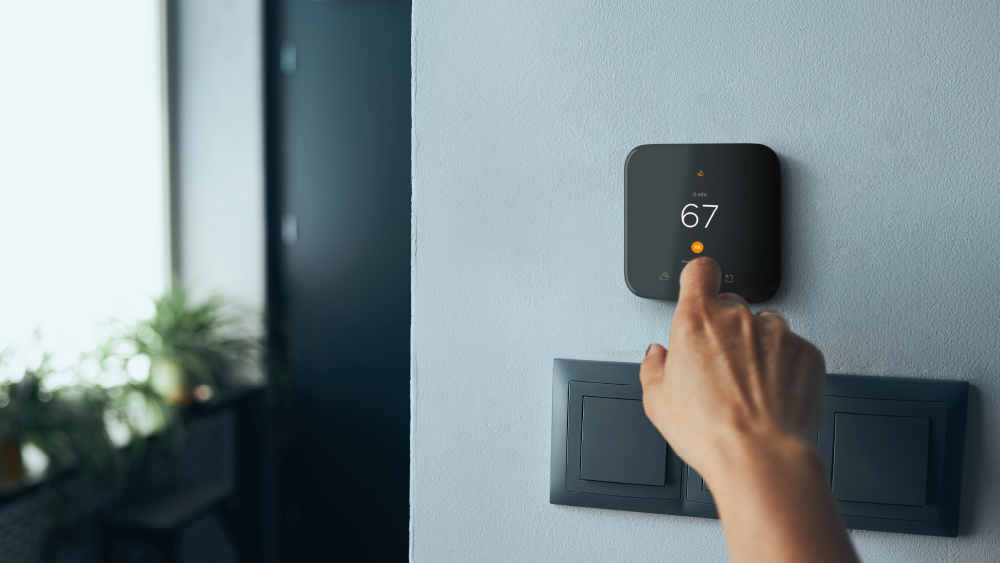
Smart home devices monitor your electricity usage and automatically turn it off when they are not in use, helping you reduce your electricity bill by a significant amount. You can also set your timers to schedule your devices to run during off-peak hours.
As heating and cooling make up a major portion of your electricity bills, invest in a smart thermostat and make use of various smart features to save on energy costs. Easily schedule when your HVAC unit operates and for how long, according to your lifestyle. Moreover, you also get valuable insights into your energy consumption patterns so you can make changes based on your budget accordingly.
Equip your HVAC system with smart features and achieve the perfect balance between comfort & savings.
Learn more
2. Choose ENERGY STAR-Rated Appliances
ENERGY STAR devices are products that go above and beyond to save energy while being environmentally responsible. Backed by the U.S. Environmental Protection Agency (EPA), these devices meet strict energy efficiency guidelines that help you identify products that use less energy and cut down on utility bills. Buying an ENERGY STAR appliance might come at a slightly higher initial investment, but it can pay off in the long run by conserving energy and minimizing your energy costs. Whether you’re in need of a new refrigerator, dishwasher, or washing machine, looking for the ENERGY STAR label is the easiest way to identify high-performing, energy-efficient models.
3. Run Your Devices During Off-Peak Hours
Electricity prices are sometimes different throughout the day. They fluctuate depending on the demand. It is the highest in the evening when most people are at home and using various appliances such as lights, HVAC units, etc.
One easy way to cut down on your electricity bill is to run your top appliances during periods of low demand. This can help you save even more money by taking advantage of the lower electricity prices that are offered during off-peak hours. You can schedule your dishwashing or laundry times for early morning or late at night when electricity demand is at its lowest.
4. Shop for Electricity
In recent years, many US states have deregulated their energy markets, giving consumers the power to shop around for their electricity. By taking advantage of this, you can save energy by locking in lower rates with third-party energy suppliers. While this process may require time and effort to consistently search for the best deals, the potential savings make it well worth the effort.
5. Schedule Energy Audit
You can boost efficiency and slash electricity bills with an energy audit. Many states offer free energy audits conducted by professionals who will visit your home to assess its efficiency. With their expert guidance, you can identify areas that need improvement
From pinpointing areas of inefficiency to suggesting upgrades like window insulation, an energy audit empowers you to make informed decisions that lead to a more environmentally friendly and cost-effective lifestyle.
Related: Is an HVAC Energy Audit Worth Going For?
6. Take Advantage of Community Solar Programs
As the need for clean energy alternatives continues to grow, so do the options to take advantage of them. Installing solar panels on your roof is one such option, allowing you to cut your electricity costs and even sell any excess energy back to the grid. However, if solar panels aren’t a viable option for you, there is an alternative: community solar. This shared solar model allows residents and businesses to subscribe to a local solar farm and receive credits off their utility bills each month.
Reducing Energy Consumption in Your Home
As the cost of living continues to rise, it’s more important than ever to be mindful of your daily energy usage. Being aware of what consumes the most electricity in your home is the first step towards effective energy management. As HVAC systems consume the most electricity, invest in smart climate control devices to save money on bills without compromising on your comfort. In addition, switching to LED light bulbs, using energy-efficient appliances, and turning off electronics when not in use can make a significant impact.








